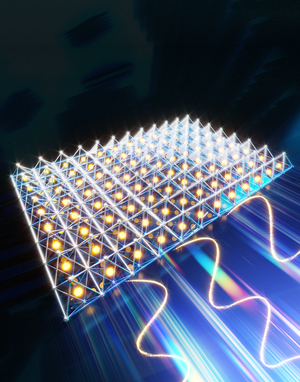Self-assembling nanoparticles lead to strong polarized light emitters
Sir Isaac Newton famously used a prism to split white light into its constituent colours. But this light is still comprised of electromagnetic radiation with a variety of different orientations. Achieving light waves with the same orientation gives rise to linearly polarized light, which is critical for a wide variety of applications, from non-invasive imaging inside the human body, achieving faster internet, to making more efficient and bright 3D television displays.

Linearly polarized light is usually obtained by passing unpolarized light through a filter (i.e. a polarizer). These filters are also used in sunglasses, and just like sunglasses, at least half of the incident energy is lost, giving much dimmer polarized light. An interdisciplinary team from Oxford and Cambridge, with Professor Robert Hoye (Tutorial Fellow in Inorganic Chemistry) as the Principal Investigator on the work, have developed devices that directly emit red linearly polarized light.
Junzhi (Jason) Ye, postdoctoral researcher at Oxford’s Department of Chemistry and a member of Professor Hoye's group, led the work. He commented:
‘Although individual anisotropic nanoparticles of halide perovskites can emit linearly polarized light, it is difficult to sustain the high degree of linear polarization when making them into films or devices, such as light-emitting diodes, or LEDs, due to the random alignment of the individual nanoparticles. Therefore, maintaining the high degree of polarization of a single nanoparticle to the device level is very challenging for commercial applications. In this work, we overcame this challenge to develop a method to self-assemble metal-halide perovskite nanoplatelets, such that our LEDs have a degree of polarization over 70%.’
Synthesizing strongly polarized light emitters
Nanoparticles have long been used to interact with light, for example in stained glass. Importantly, as the size becomes very small, energy levels change from being continuous (as in conventional semiconductors) to discrete (like atoms). This phenomenon is called quantum confinement, in which reducing the size of the nanoparticle further leads to energy levels becoming more discrete and more widely spaced from each other. Metal-halide perovskites have recently emerged as remarkable light emitters and can be synthesized as nanoparticles using simple wet chemistry methods.
The researchers developed an approach to synthesize perovskite nanoparticles that are 20 nm in length and width, but only 3 monolayers in thickness (i.e., nanoplatelets). This means that there is stronger quantum confinement along the thickness dimension than along the length/width. As a result, the dipole coming out of the faces of the nanoplatelets is at a different energy than the two dipoles along the length/width of the nanoplatelets. The electromagnetic radiation associated with this out-of-plane dipole is strongly linearly polarized. Isolating only the light associated with this dipole will therefore lead to polarized light emission.
Self-assembling perovskite nanoplatelets
The researchers discovered a simple approach to self-assemble the nanoplatelets so that they stand up on their edge. This means that the emission coming out from the nanoplatelets following electrical charge injection is mostly from the out-of-plane dipole, leading to LEDs with a degree of polarization exceeding 70%. Remarkably, this was achieved using a simple device substrate, without using any advanced photonic gratings to enhance the degree of polarization. For context, going from individual nanoparticles to films usually reduces the degree of polarization from 65-100% down to <60%, while taking these films into devices reduces this further to <35% due to the increasing randomization of how the nanoparticles are oriented.
Self-assembly of the perovskite nanoplatelets was achieved by dispersing the nanoplatelets in a volatile alkane solvent. By spreading the colloidal solution of nanoplatelets over the device substrate uniformly and evaporating away the alkane solvent (hexane) quickly, the nanoplatelets are kinetically trapped in the edge-up orientation, stacking together uniformly.
Future opportunities
Professor Hoye commented:

‘These are very promising results that open up new opportunities to achieve cost-effective polarized light emitters that can be used in a wide variety of imaging, communication and display applications. We are very excited about following through with the important conceptual advances made in this work to realize more complex self-assembled structures, and, in the future, as potential materials for single photon emitters for quantum technologies.’
The article about the team's findings can be read in Nature Photonics: J. Ye, et al. ‘Direct linearly polarized electroluminescence from perovskite nanoplatelet superlattices’, 2024.